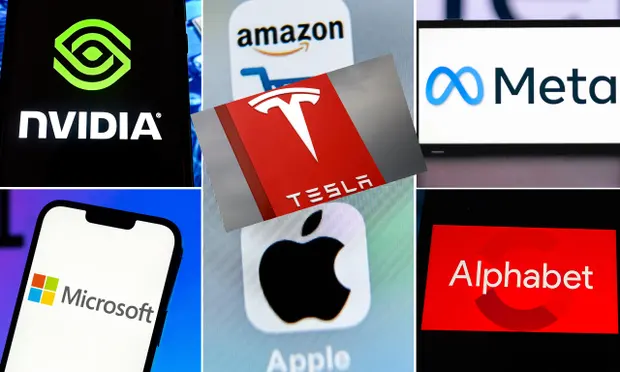The FAANGs, or the five major US tech stocks that dominated the investment scene in the past, were Google (now Alphabet), Facebook (now Meta), Amazon, Apple, and Netflix. That image is no longer current. Introducing the so-called Super Seven or Magnificent Seven, which comprise Microsoft, Tesla, Nvidia, and four of the aforementioned companies (Netflix being the lone exception). The dominance of this group will be the stock market tale of 2023.
According to Duncan Lamont, head of strategic research at fund manager Schroders, the graphic below is “one for the ages.” It demonstrates how investing through one of the largest and most popular “global” stock market indices will nonetheless result in a portfolio that is heavily American and heavily weighted toward US technology.
The MSCI All Country World Index (ACWI) measures around 3,000 large and mid-sized companies in 23 developed nations and 24 emerging markets, including about 85% of “the global investable equity opportunity,” as the compilers describe it. A company’s weighting in the index increases with its increasing value.
The seven currently make up 17.2% of the total, with the combined representatives of China, France, Japan, the UK, and Canada contributing 17.3%. Five countries equal seven US corporations. According to Lamont, “this is far from diversified exposure.” At $3 trillion in market value, Apple is worth more than the whole UK stock market.
Part of the reason the figures are so startling now is what the second chart illustrates. The group of seven has increased in value by 74% in 2023 as of last week. Within the same ACWI index, the remaining global equity market has performed at a rate of 12%. It was difficult to stay up if the Magnificent Seven were absent from your portfolio in 2023.
Is this level of focus beneficial? It’s unheard of, for sure. US equities currently make up 63% of the ostensibly global ACWI, thanks to the whoosh from the seven in 2023. Japan barely made up 44% of the same index, even during the heyday of its economic miracle. According to Lamont, “the US has far outpaced Japan’s level of concentration in the 1980s, which everyone thought was extreme at the time.”
However, it is difficult to contest that the kind of irrational speculation that fueled the dotcom bubble at the start of the century has contributed to the growth of the seven. It is indisputable that Nvidia’s order book for computer chips is expanding as the artificial intelligence (AI) revolution arrives, despite the company’s stock price rising 240% this year. This increase may or may not be exaggerated.
It would also be incorrect to consider the seven to be completely similar. Amazon, Google, and Microsoft all hold dominant positions in expanding markets, and each has sizable cloud services sections. However, Microsoft’s primary software company is distinct from Amazon’s retail segment, and Google’s search business is not at all similar to Amazon’s. AI may help everyone, though to varying degrees, which is one reason why the stock market is rediscovering technology in 2023 following a particularly “down” year in 2022. Tesla’s primary business is still producing electric cars.
It would probably be wiser to just consider the effects of such great market concentration. Just seven stocks can cause a lot of risk in both directions in a well diversified investment portfolio.
Lamont raises a few issues. First off, it isn’t quite accurate to say—despite statistical accuracy—that the US stock market is currently valued at historically low levels. Instead, it is a reflection of the seven’s influence. He claims that “US exceptionalism is not all stocks.” “Everything in its path is being crushed by this small number.” When measured using conventional investment criteria, the average US stock is not pricey.
Second, when equities are priced for perfection, there is potential for disappointment. According to Schroders’ research, times of significant market concentration are typically followed by times when larger stocks do worse. Lamont acknowledges that “this time may be different and we are in somewhat mapped territory.”
As an active management business, Schroders seems well-suited to argue that the tide is turning away from passive index-followers. However, it seems intuitively clear that the main point—that investors may be undervaluing the relative lack of diversity and that the current concentration is unusual and out of step with historical norms—is valid. Although timing is never easy, a reversal seems to be the best option.





